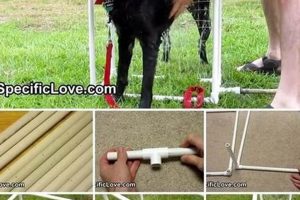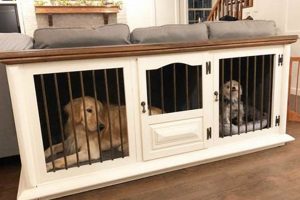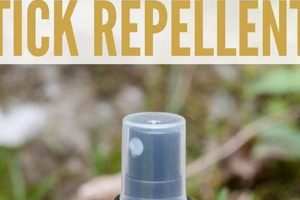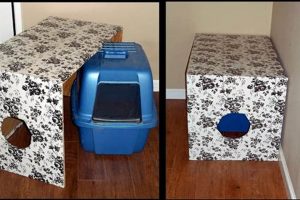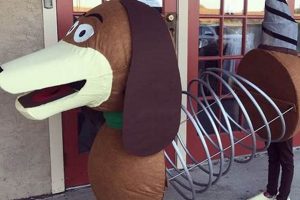Creating personalized neckwear for canine companions through self-directed crafting is a popular activity. This pursuit involves individuals utilizing various materials and techniques to fashion accessories, often triangular or square in shape, intended to be tied around a dog’s neck. An example includes selecting a patterned cotton fabric, cutting it to size, hemming the edges, and securing it around the animal’s neck.
The practice offers several advantages. It provides a cost-effective alternative to purchasing commercially produced items, allows for customization to reflect the owner’s or the pet’s personality, and can be a fulfilling creative endeavor. Historically, such handcrafted items likely arose from a desire to individualize a pet’s appearance with readily available materials.
Subsequent sections will delve into specific fabric choices, construction methods, sizing guidelines, and embellishment options for producing these personalized canine accessories.
Essential Guidance for Crafting Canine Neckwear
The following recommendations offer practical guidance for creating durable and aesthetically pleasing accessories for dogs.
Tip 1: Fabric Selection is Paramount: Opt for durable, washable fabrics such as cotton, linen, or flannel. Avoid materials that fray easily or contain embellishments that could be ingested by the animal.
Tip 2: Prioritize Accurate Measurement: Measure the circumference of the dog’s neck to determine the appropriate dimensions. Add several inches to ensure comfortable fitting and ease of tying. An overly tight accessory can cause discomfort or restrict breathing.
Tip 3: Employ Secure Seams: Utilize a sewing machine or employ sturdy hand-sewing techniques to create durable seams. Reinforce stress points, such as corners and tie ends, to prevent unraveling during wear and washing.
Tip 4: Consider the Season: Choose lightweight, breathable fabrics for warmer weather and thicker, insulating fabrics for cooler climates. Consider the dog’s coat type and activity level when selecting materials.
Tip 5: Prioritize Safety: Avoid using materials with small, detachable parts that the dog could chew off and swallow. Ensure the accessory fits securely but not too tightly to prevent choking hazards.
Tip 6: Incorporate Reflective Elements: For increased visibility during walks in low-light conditions, consider adding reflective tape or fabric to the accessory. This enhances safety for both the dog and owner.
Tip 7: Pre-Wash Fabrics: Always pre-wash fabrics before cutting and sewing to prevent shrinkage after the finished product is laundered. This ensures a consistent fit and prevents distortion of the seams.
By adhering to these guidelines, individuals can craft safe, comfortable, and visually appealing accessories that enhance their canine companion’s appearance and well-being.
The subsequent section will address design considerations and personalization techniques to further enhance the crafting experience.
1. Fabric Durability
The selection of materials with inherent resistance to wear and tear directly impacts the longevity and functionality of canine neckwear produced through self-directed crafting. The correlation between fabric durability and the lifespan of the accessory is evident: inferior materials degrade rapidly, necessitating frequent replacements, whereas robust fabrics withstand repeated use and laundering. A cotton-polyester blend, for example, exhibits greater resilience than a delicate silk fabric. This is crucial, as canine accessories are often subjected to considerable abrasion during daily activities.
The absence of durable fabrics can result in several adverse consequences. Fraying, tearing, and fading compromise the item’s aesthetic appeal and structural integrity. Furthermore, weakened fabrics pose a safety hazard if they disintegrate during use, potentially leading to entanglement or ingestion of loose threads. The cost-effectiveness of producing these items is diminished if frequent replacement becomes necessary. An illustrative example is a bandana constructed from thin, loosely woven cotton, which may only last a few washes before requiring repair or disposal.
Therefore, the selection of materials with high tensile strength, resistance to abrasion, and colorfastness is paramount. Incorporating durable materials into the crafting process ensures that the finished product not only serves its intended aesthetic purpose but also provides sustained functionality and safety for the canine companion. In essence, prioritizing fabric durability is critical in maximizing the value and practicality of self-made canine accessories.
2. Accurate Sizing
The precision of dimensions represents a critical determinant in the usability and safety of self-made canine neckwear. Inadequate measurements can lead to discomfort, restriction of movement, or even potential health risks for the animal. An undersized accessory may constrict the dog’s neck, impeding breathing or circulation, while an oversized item poses a risk of entanglement or becoming a tripping hazard during activity. This is of particular importance with brachycephalic breeds, where respiratory systems are already compromised.
The process of achieving accurate sizing involves several considerations. Measuring the circumference of the dog’s neck with a flexible measuring tape provides a baseline. Additional allowance must be factored in to ensure a comfortable, non-restrictive fit, generally adding one to two inches. It is essential to account for the thickness of the dog’s fur, as a dense coat can impact the perceived tightness of the accessory. Failing to consider these factors may result in a product that is unsuitable for its intended purpose. An example includes a bandana designed based solely on estimated measurements that subsequently proves too tight, causing visible irritation and discomfort around the dog’s neck.
Consequently, meticulous attention to sizing is paramount for producing functional and safe canine neckwear. Prioritizing accurate measurements during the design and construction phases mitigates potential harm and ensures the accessory is both comfortable and visually appealing. By carefully accounting for individual canine anatomy and adjusting measurements accordingly, the overall quality and suitability of self-made accessories are significantly enhanced.
3. Secure Construction
The longevity and safety of canine accessories created through self-directed crafting are directly contingent upon the implementation of secure construction methods. Inferior stitching, loosely fastened embellishments, or improperly secured closures significantly increase the risk of product failure, posing potential hazards to the animal. If seams unravel, the accessory may become detached during activity, creating a tripping hazard or presenting an opportunity for the dog to ingest loose fabric. A weakly attached decorative element, such as a button or sequin, can detach and become a choking hazard if ingested. Therefore, secure construction is not merely a matter of aesthetic presentation but a fundamental requirement for ensuring the safety and practicality of the item.
Achieving secure construction involves several key techniques. Employing a reinforced stitch, such as a backstitch or zigzag stitch, along seams is crucial for preventing unraveling. Using durable thread, appropriate for the fabric weight, further enhances seam integrity. Attaching embellishments with multiple secure stitches, or using adhesive specifically designed for fabric, minimizes the risk of detachment. Closures, such as snaps or Velcro, should be securely fastened to prevent unintentional opening during use. An example illustrating the importance of these techniques involves a bandana constructed with a simple straight stitch and lightweight thread. After only a few uses, the seams begin to unravel, requiring frequent repairs or ultimately rendering the item unusable.
In conclusion, prioritizing secure construction is essential for maximizing the value and minimizing the risks associated with self-made canine accessories. The implementation of appropriate stitching techniques, durable materials, and secure closures directly contributes to the item’s durability, safety, and overall suitability for its intended purpose. Neglecting these considerations compromises the integrity of the product and introduces potential hazards for the animal. A well-constructed accessory not only enhances the dog’s appearance but also provides a secure and long-lasting addition to its wardrobe.
4. Washable Materials
The inherent connection between washable materials and self-directed creation of canine neckwear lies in the practical requirements of hygiene and maintenance. Canine accessories are routinely exposed to dirt, saliva, and other environmental contaminants. Consequently, the utilization of materials amenable to frequent laundering is not merely a matter of convenience but a necessity for maintaining both the dog’s health and the accessory’s aesthetic appeal. The selection of non-washable fabrics introduces a heightened risk of bacterial proliferation and odor retention, ultimately impacting the lifespan and utility of the item. A notable example includes accessories crafted from leather or delicate silks, which, due to their laundering limitations, are often relegated to infrequent use or require specialized cleaning procedures that are both costly and inconvenient.
The importance of washable materials extends beyond basic cleanliness. Frequent washing is critical for removing allergens, such as pollen and dust mites, that may accumulate on the fabric and trigger allergic reactions in both the dog and its owner. Durable, washable fabrics, such as cotton, linen, and polyester blends, offer a practical solution by allowing for repeated laundering without significant degradation of the material’s structural integrity or colorfastness. For instance, a bandana constructed from a high-quality cotton blend can withstand numerous wash cycles, retaining its shape, color, and overall functionality, thereby providing a cost-effective and hygienic solution.
In summary, the selection of washable materials is paramount in the production of durable, hygienic, and aesthetically pleasing canine neckwear through self-directed crafting. Neglecting this consideration undermines the long-term value and practicality of the item, potentially exposing the dog and its owner to health risks. Embracing washable fabrics ensures that the finished product not only enhances the dog’s appearance but also provides a clean and safe accessory suitable for frequent use. The understanding of this nexus is crucial for those engaged in this process.
5. Safety Provisions
The implementation of safety provisions represents a cardinal consideration in the domain of self-directed creation of canine neckwear. The potential risks associated with ill-conceived or poorly executed designs mandate a rigorous focus on preemptive safety measures. The cause-and-effect relationship between inadequate safety provisions and potential harm to the animal is readily apparent: improperly secured fastenings can detach, posing choking hazards, while overly tight designs can impede respiration. The significance of safety as an intrinsic component of this creative process cannot be overstated. Real-world examples frequently illustrate instances where canine accessories lacking appropriate safety features have resulted in injury or distress to the animal.
Practical application of this understanding necessitates careful material selection and construction techniques. The use of non-toxic fabrics, the avoidance of small, detachable embellishments, and the incorporation of breakaway closures are all critical elements. Breakaway closures, such as those employing Velcro or quick-release buckles, allow for rapid removal of the accessory in the event of entanglement or other emergencies. Furthermore, reflective materials can enhance visibility in low-light conditions, mitigating the risk of vehicular accidents. The size and fit of the item must be meticulously calibrated to prevent constriction or chafing. Failure to adhere to these principles directly compromises the welfare of the canine.
In summary, the integration of comprehensive safety provisions is not merely an optional embellishment but an ethical imperative in the creation of canine neckwear. Challenges in this area include balancing aesthetic design with functional safety requirements and ensuring that all construction materials meet stringent non-toxicity standards. By prioritizing safety and adhering to established best practices, individuals engaged in self-directed crafting can produce accessories that are both visually appealing and demonstrably safe for their canine companions.
6. Design Aesthetics
Design aesthetics, pertaining to the visual appeal and artistic characteristics of canine neckwear, constitutes a significant element within the context of self-directed fabrication. The aesthetic qualities of a handmade bandana directly influence its desirability and perceived value. A skillfully designed item, incorporating harmonious color palettes, visually appealing patterns, and complementary embellishments, is more likely to be embraced and worn with pride by both the canine and its owner. Conversely, a poorly designed bandana, characterized by clashing colors, haphazard construction, or inappropriate embellishments, may diminish the overall appeal and functionality of the accessory. The cause-and-effect relationship is evident: thoughtfully considered aesthetics enhance the perceived quality and utility of the handmade item.
The integration of design aesthetics transcends mere superficiality. It involves careful consideration of fabric selection, pattern placement, and embellishment choices to create a cohesive and visually pleasing product. For instance, a bandana crafted from high-quality cotton featuring a classic plaid pattern exudes a timeless appeal, while an item adorned with whimsical appliques may convey a sense of playfulness. Real-world examples demonstrate the impact of design aesthetics on customer preference. Online marketplaces are replete with examples of handcrafted bandanas commanding premium prices due to their exceptional design and craftsmanship. The practical significance of this understanding lies in the ability to create accessories that not only serve a functional purpose but also enhance the overall aesthetic of the canine companion.
In summary, design aesthetics plays a crucial role in determining the overall appeal and desirability of self-made canine neckwear. Challenges in this domain include navigating the complexities of color theory, pattern selection, and embellishment techniques to achieve a harmonious and visually pleasing result. Furthermore, the balancing act between functional practicality and aesthetic expression requires careful consideration. By prioritizing design aesthetics and employing sound design principles, individuals can create accessories that are not only functional and safe but also serve as a stylish expression of their canine companion’s personality and individuality. The overarching theme emphasizes that visual appeal is not merely an afterthought but an integral component of the overall value proposition of self-made canine neckwear.
7. Cost Effectiveness
The correlation between self-directed creation of canine neckwear and reduced expenditure represents a salient factor in its widespread appeal. The practice allows individuals to circumvent the retail market, where commercially produced items often command prices disproportionate to their material costs or functional value. Direct creation from readily available or repurposed materials translates to significant cost savings, particularly for owners with multiple dogs or those desiring a diverse collection of accessories. The causal relationship is clear: Direct involvement in the fabrication process minimizes reliance on external suppliers and associated markups. The relative importance of cost-effectiveness is amplified for individuals operating within constrained budgets or those seeking to maximize the utility of existing resources. Numerous online communities and tutorials showcase examples of attractive and functional canine bandanas crafted from reclaimed fabric scraps, further substantiating the potential for significant cost reduction. This understanding underscores the pragmatic value proposition of self-directed crafting.
Further analysis reveals that cost-effectiveness extends beyond the initial purchase price. Commercially produced items may require specialized cleaning or be prone to rapid wear and tear, necessitating frequent replacements and incurring additional expenses. Conversely, handmade accessories, constructed from durable and washable materials, offer a more sustainable and cost-efficient alternative. The practical application of this principle involves strategically sourcing affordable fabrics, utilizing efficient pattern-making techniques, and mastering basic sewing skills to minimize material wastage and labor costs. The ability to customize designs and repurpose existing materials further enhances the cost-effectiveness of the process.
In summary, the emphasis on cost-effectiveness in the self-directed fabrication of canine neckwear highlights its accessibility and practicality for a broad spectrum of individuals. Navigating the balance between material quality, design complexity, and overall budget represents a key challenge. However, by prioritizing resourcefulness, utilizing readily available materials, and mastering basic construction techniques, individuals can achieve substantial cost savings while simultaneously creating functional and aesthetically pleasing accessories for their canine companions. The broader theme emphasizes that creativity and resourcefulness can converge to produce tangible economic benefits.
Frequently Asked Questions About Creating Canine Neckwear
The following questions and answers address common concerns and misconceptions regarding the self-directed creation of neckwear for canine companions.
Question 1: What fabric types are most suitable for crafting durable and safe canine bandanas?
Durable and washable fabrics such as cotton, linen, denim, and flannel are recommended. Avoid using easily frayed fabrics, materials with small embellishments that could be ingested, or potentially allergenic substances.
Question 2: How does one determine the appropriate size for a handcrafted canine bandana?
Measure the circumference of the dog’s neck using a flexible measuring tape. Add one to two inches to this measurement to ensure a comfortable, non-restrictive fit. Account for the thickness of the dog’s fur when determining the final dimensions.
Question 3: What stitching techniques are most effective for ensuring the durability of seams in a homemade bandana?
Employing a reinforced stitch, such as a backstitch or zigzag stitch, is crucial for preventing unraveling. Double stitching seams and reinforcing stress points, such as corners, further enhances seam integrity.
Question 4: How can the safety of a self-made canine bandana be maximized?
Avoid using small, detachable components that could pose a choking hazard. Implement breakaway closures, such as Velcro or quick-release buckles, to allow for rapid removal in emergency situations. Ensure the accessory fits securely but not tightly to prevent constriction.
Question 5: What cleaning and maintenance procedures are recommended for handcrafted canine bandanas?
Launder the accessory regularly using a mild detergent and warm water. Tumble dry on low heat or hang to dry. Inspect the bandana periodically for signs of wear and tear, and repair any damage promptly.
Question 6: Are there specific design considerations for bandanas intended for use in different weather conditions?
Opt for lightweight, breathable fabrics for warmer weather and thicker, insulating fabrics for cooler climates. Consider incorporating reflective elements for increased visibility during low-light conditions.
In summary, the self-directed creation of canine neckwear necessitates careful attention to material selection, sizing, construction techniques, and safety considerations. Adhering to these guidelines ensures the production of durable, comfortable, and safe accessories for canine companions.
The following section will explore advanced customization techniques and design variations for crafting unique canine bandanas.
DIY Dog Bandana
This exploration of the “diy dog bandana” reveals a multifaceted undertaking, demanding consideration of fabric durability, accurate sizing, secure construction, washable materials, stringent safety provisions, design aesthetics, and cost-effectiveness. Mastery of these elements ensures the creation of canine accessories that are not only visually appealing but also safe, comfortable, and long-lasting.
Continued adherence to the principles of responsible craftsmanship, coupled with ongoing innovation in design and material selection, will undoubtedly elevate the standards of handmade canine accessories. The pursuit of excellence in this endeavor necessitates a commitment to continuous learning and a steadfast dedication to the well-being of canine companions.



